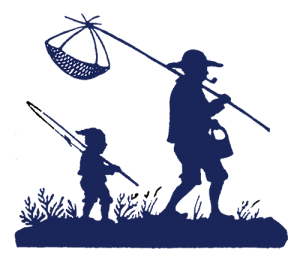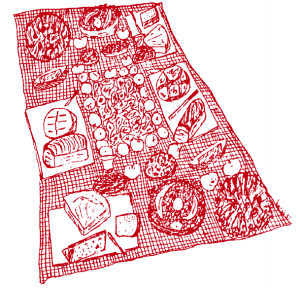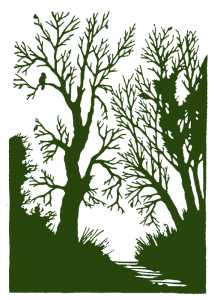 Country Rambles
Country Rambles
Steve Van Matre

 n the 70’s, we held our original Acclimatization Workshops at George Williams College in southern Wisconsin. Driving up from the Chicago area into that rolling countryside, I was always attracted by one particular vista near the campus. Nestled atop a forested ridge on the other side of the valley, a large farm overlooked the marshy end of a long, narrow lake. Like the “eye-catchers” in early English landscape gardens, this pastoral scene always managed to capture my attention. About halfway down the hillside below the barn, just at the edge of the pasture and above the marshland below, there were a couple of huge, spreading trees. I always thought they provided the perfect setting for an idyllic picnic.
n the 70’s, we held our original Acclimatization Workshops at George Williams College in southern Wisconsin. Driving up from the Chicago area into that rolling countryside, I was always attracted by one particular vista near the campus. Nestled atop a forested ridge on the other side of the valley, a large farm overlooked the marshy end of a long, narrow lake. Like the “eye-catchers” in early English landscape gardens, this pastoral scene always managed to capture my attention. About halfway down the hillside below the barn, just at the edge of the pasture and above the marshland below, there were a couple of huge, spreading trees. I always thought they provided the perfect setting for an idyllic picnic.
When we decided to offer an Advanced Acclimatization Workshop, our development team wanted to do something a bit different. In our basic workshop we had talked about our Earth Journeys™, first mentioned in Acclimatizing, so we decided to include a short journey where the participants could actually get a firsthand feeling for that kind of activity. We called it the Country Ramble.
Basically, we aimed to convey the feeling that we were ambling through the surrounding countryside with no particular goal or destination in mind, other than that of just reveling in the day. The poet Virgil said, “Steep thyself in a bowl of summertime.” And that’s what we aimed to do – whatever the season – to steep ourselves in a bowl of it. We were going out just to soak up the elements of life. We even decided to go in silence just so our chattering with one another wouldn’t get in the way.
Recalling the farm on the hill nearby, I suggested that for the perfect ending to our wanderings we should lay out something akin to an old-fashioned picnic up there under those magnificent trees. At the outset, everyone nodded in agreement, but their support waned noticeably as I continued elaborating upon what I had in mind.
“I want red and white checked tablecloths,” I explained, “and cloth napkins. We shouldn’t have any paper or plastic or foil either. Let’s make it all natural. We’ll just have finger foods, and people can fill their napkins with chunks of bread and cheese, pieces of fruit and vegetables, etc. And let’s make it a surprise — like the whole thing just appeared magically for us, and we’ll wander in there and find it. Oh, yes, I want real wine glasses too….” By this time, the “Now, Steve’s…” had begun to surface, but I was on a roll and my growing enthusiasm carried the day.
Getting Ready for the Journey 
Originally, the idea of the Country Ramble was to wander through an area where people lived closer to the land, not a wilderness, but an area dotted with pockets of wildness. We wanted our participants to experience the natural setting for a way of life in which (as Thoreau put it) you could have a foot in both worlds, the natural and the human. So it is important to choose a location where the human presence can still be felt… and enjoyed. Select a spot where the surprise collation will be laid out so that the participants come upon it suddenly, perhaps just over a hill, around a bend, or through a secret opening in the undergrowth. And make sure the “gnomes” who arrange everything are hidden away before the arrival. Scatter red and white checked tablecloths around the clearing (placing them just far enough apart so people will feel separated, but still part of the overall group.)  Tie cloth napkins around the stems of the wine glasses and sit them in the center of the tablecloths around a jug of water and a bottle of light wine (straw covered bottles add a nice touch).
Tie cloth napkins around the stems of the wine glasses and sit them in the center of the tablecloths around a jug of water and a bottle of light wine (straw covered bottles add a nice touch).
Arrange the natural “buffet” on a larger piece of darker cloth (say, about 9′ x 3′ for a big group). Remember, there should be no paper or plastic or foil, so choose natural materials for the containers. Use large chunks of cheese and loaves of bread placed on cross sections of wood, baskets of fruit, trays of vegetables, wooden bowls of nuts, etc. And make sure everything is artfully arranged, like a postcard scene of an idyllic repast. (Pay particular attention to those small details too, like the heft and feel of the cutting knife, or the size and color of the vegetables, the shape and texture of the water jugs, etc.)
Before the departure, pass out large bandannas to the participants. (We call them “soft tools” and make them up especially for our events, silk-screening a different logo on them each time.) Explain that the participants should use these to mark neat discoveries they make as they wander along. They can roll them up and leave them in a circle around something or tie them to it if necessary, then the other participants will know to stop and take a look at their “finds.” (Those who left them can retrieve them on their return.)
Emphasize that the idea of a ramble is just to poke along silently, checking things out that would ordinarily be overlooked. Point out the general direction they will be heading, and ask everyone to spread out but to always keep a few people in view. Tell them to just follow the general trail of bandannas. (If maintaining the route will be difficult, have a “helper” in the group get out in front while people are exploring and surreptitiously tie bandannas to some predetermined things in order to highlight the way.) Explain that the idea of the ramble is to get out of all the words and chatter, and get into looking with the heart, not just the eyes. The natural world is an endless source of soothing beauty if we can learn to pause and open ourselves to it. As John Muir expressed it: “Between every two pines is a doorway to a new world.” Even though the participants are going in silence, they will be aware of other people drifting along in the same general direction, and the bandannas provide a feeling of group sharing. Like eddies in a stream, small clusters of folks will form around a particularly intriguing item, then break up and flow on across the land. Of course, there will be lots of smiles as they share nonverbally in their discoveries.
Just before setting off, explain that it’s time to lower the veil of silence. Pinching your thumb and fingers together like you’re holding up a curtain, raise both of your arms slightly above your head, then slowly lower the “veil” in front of you.  It may sound silly, but try it. It’s a great attention-getting reminder and raises the curtain on the entire experience (even if it’s coming down in this case instead of going up).
It may sound silly, but try it. It’s a great attention-getting reminder and raises the curtain on the entire experience (even if it’s coming down in this case instead of going up).
Since you will be ahead of the others, you should arrive first at the spot for the surprise meal. If you have a small group, you can stop just short of the hidden location and motion folks as they wander in to have a seat somewhere in this “waiting area.” (It’s a nice touch to walk the last segment together and discover your lunch magically awaiting you.) With a larger group you can go ahead and sit down yourself within sight of the tablecloths as soon as you arrive, and others will drift in to join you. When all the participants have arrived, motion them to form a circle around the “buffet,” then reach down and ceremoniously raise the veil of silence with them. Now you can dig in. It’s time to just enjoy the day, the people, and the abundance of the land. If you have set everything up just right, and paid attention to the details and touches, you will relish these moments — knowing from the sighs of contentment and quiet conversation that you have arranged a truly magical experience for the participants.
After the meal, ask the group to form a large circle nearby (explaining that the “gnomes” will take care of tidying up when you’ve gone), then sit down and share some passages with them from The Earth Speaks. When you have finished your readings, ask the participants to turn around right where they’re sitting in the circle and look for a special spot somewhere out there in front of them, away from the group. Then have them walk out to it and sit down and just listen to the Earth speaking to them for a few minutes before your return.
General Notes
- Use a special signal to call everyone together at the end — perhaps a conch shell or a bird call.
- On the way back people can pick up their bandannas and share verbally some of the discoveries they made in silence on the way out. Give them a time deadline though if it is important to get everyone together again.
- Be sure all the participants take raingear along, but ask them to leave the cameras, binoculars, and cell phones behind.
- If necessary, establish a time and place for any “smokers.”
- If you use the “Jumping Mouse” story from The Earth Speaks for your reading (one of our favorites), go to the source, Seven Arrows and pull out the chief’s explanations of what’s happening. We left them out in our version, but when you’re reading the story to a group, it’s nice to include them much as the storyteller would have done. Just jot them down in the margins of The Earth Speaks.
- See Acclimatizing for more background on our Earth Journeys™ (originally called the Group Journeys), particularly the explanation of the “soft tools” in the Crusoe Camp™ chapter.
- Have a couple of secret “helpers” who know the destination wander along with the others so they can subtly set the direction and reel in the stragglers. With a fairly large group, it is a good idea to give them more of a time frame, saying everyone will join up in about a half an hour or so near some easy to spot landmark. (The actual “rambling” should take about 30-45 minutes.)
- If you feel there must be something in the meal for the carnivores, try pieces of baked chicken. Keep all the food on the chunky side though, don’t peel it or cut it all up and alter its appearance too much.
- Be sure not to overdo it on the wine, especially if there will be a longer reading.
- Family farms and country lanes are almost gone now in many areas, replaced by agribusiness and asphalt, but try to select an area where some Arcadian qualities (or remnants) can still be experienced.
Copyright © 1988 The Institute for Earth Education www.ieetree.org
Props
- “soft tools” (these cloth bandannas need to be larger than normal, 18” squares work well)
- cloth napkins and wine glasses
- individual “sit-upons” (squares of old carpet, for example)
- bird call or conch shell
- tablecloths
- natural “buffet” foods (loaves of bread, chunks of cheese and vegetables, fruits and nuts, etc.)
- natural bowls, baskets, and boards
- wine and water, plus a nonalcoholic alternative beverage
- The Earth Speaks
- cutting knives
